What is a tornado?
A tornado is a violent rotating column of air extending from a thunderstorm to the ground. The most violent tornadoes are capable of tremendous destruction with wind speeds of up to 300 mph. They can destroy large buildings, uproot trees and hurl vehicles hundreds of yards. They can also drive straw into trees. Damage paths can be in excess of one mile wide to 50 miles long. In an average year, 1000 tornadoes are reported nationwide.
With extreme weather, emergency disaster's happen all the time, so you need survival food when the weather turns ugly. By taking special precautions and having an emergency food supply, you'll be much more likely to stay safe.
How do tornadoes form?
Most tornadoes form from thunderstorms. You need warm, moist air from the Gulf of Mexico and cool, dry air from Canada. When these two air masses meet, they create instability in the atmosphere. A change in wind direction and an increase in wind speed with increasing height creates an invisible, horizontal spinning effect in the lower atmosphere. Rising air within the updraft tilts the rotating air from horizontal to vertical. An area of rotation, 2-6 miles wide, now extends through much of the storm. Most strong and violent tornadoes form within this area of strong rotation.
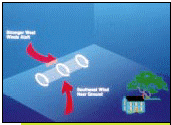 | 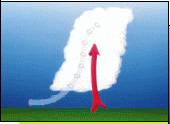 | 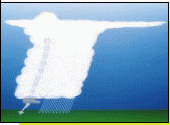 |
Click Here to learn more about tornadoes from NOAA.
What is a funnel cloud?
A funnel cloud is a rotating cone-shaped column of air extending downward from the base of a thunderstorm, but not touching the ground. When it reaches the ground it is called a tornado.
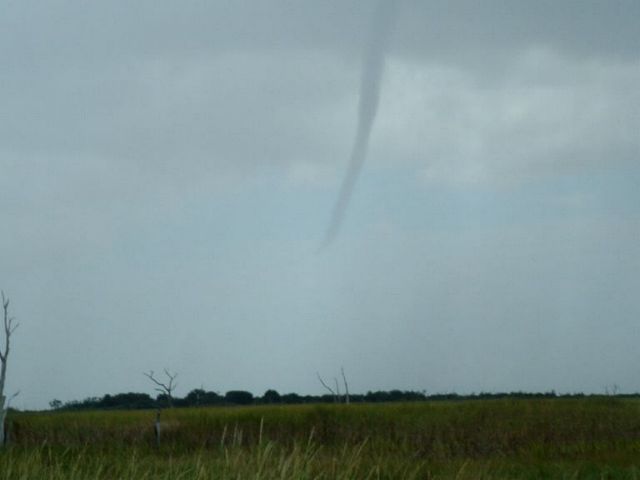
How do tornadoes stop?
It is not fully understood about how exactly tornadoes form, grow and die. Tornado researchers are still trying to solve the tornado puzzle, but for every piece that seems to fit they often uncover new pieces that need to be studied.
What is a supercell thunderstorm?
A supercell thunderstorm is a long-lived thunderstorm whose updrafts and downdrafts are in near balance. These storms have the greatest tendency to produce tornadoes that stay on the ground for long periods of time. Supercell thunderstorms can produce violent tornadoes with winds exceeding 200 mph.
What is a mesocyclone?
A mesocyclone is a rotating vortex of air within a supercell thunderstorm. Mesocyclones do not always produce tornadoes.

What is a wall cloud?
A wall cloud is an abrupt lowering of a rain-free cumulonimbus base into a low-hanging accessory cloud. A wall cloud is usually situated in the southwest portion of the storm. A rotating wall cloud usually develops before tornadoes or funnel clouds.
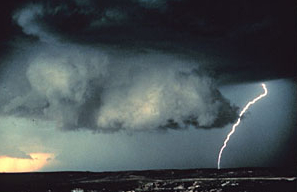
What is a waterspout?
A waterspout is just a weak tornado that forms over water. They are most common along the Gulf Coast. Waterspouts can sometimes move inland, becoming tornadoes causing damage and injuries.
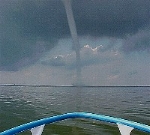
What is hail?
Hail is created when small water droplets are caught in the updraft of a thunderstorm. These water droplets are lifted higher and higher into the sky until they freeze into ice. Once they become heavy, they will start to fall. If the smaller hailstones get caught in the updraft again, they will get more water on them and get lifted higher in the sky and get bigger. Once they get lifted again, they freeze and fall. This happens over and over again until the hailstone is too heavy and then falls to the ground.

What is the largest hailstone recorded in the United States?
According to the National Weather Service, the largest hailstone is 8 inches in diameter and weights approximately 2 pounds. It fell in Vivian, South Dakota on July 23, 2010.
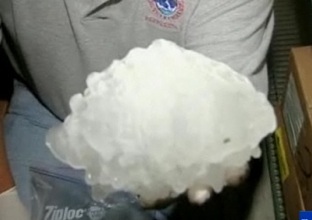
What is a gustnado?
A gustnado is a short-lived, relatively weak whirlwind that forms along a gust front. A gust front is the surge of very gusty winds at the leading edge of a thunderstorm's outflow of air. Gustnadoes are not tornadoes. They do not connect with any cloud-base rotation. But because gustnadoes often have a spinning dust cloud at ground level, they are sometimes wrongly reported as tornadoes. Gustnadoes can do minor damage.
What is a landspout?
A landspout is a very weak tornado that is not associated with a wall cloud or a mesocyclone. It is the land equivalent of a waterspout.
When are tornadoes most likely to occur?
Tornadoes can happen at any time of the year and at any time of the day. In the southern states, peak tornado season is from March through May. Peak times for tornadoes in the northern states are during the summer. A few southern states have a second peak time for tornado outbreaks in the fall. Tornadoes are most likely to occur between 3 p.m. and 9 p.m.
Where are tornadoes most likely to occur?
The geography of the central part of the United States, known as the Great Plains, is suited to bring all of the ingredients together to forms tornadoes. More than 500 tornadoes typically occur in this area every year and is why it is commonly known as "Tornado Alley".
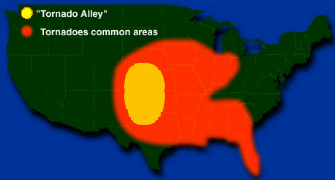
TORNADO WATCH - Tornadoes are possible in your area. Stay tuned to the radio or television news.
TORNADO WARNING - A tornado is either on the ground or has been detected by Doppler radar. Seek shelter immediately!
Click Here to see if there are any active warnings in your area.
| SCALE | WIND SPEED | POSSIBLE DAMAGE | Enhanced, Operational Fujita Scale |
| F0 | 40-72 mph | Light damage: Branches broken off trees; minor roof damage | EFO 65-85 mph |
| F1 | 73-112 mph | Moderate damage: Trees snapped; mobile home pushed off foundations; roofs damaged | EF1 86-110 mph |
| F2 | 113-157 mph | Considerable damage: Mobile homes demolished; trees uprooted; strong built homes unroofed | EF2 111-135 mph |
| F3 | 158-206 mph | Severe damage: Trains overturned; cars lifted off the ground; strong built homes have outside walls blown away | EF3 136-165 mph |
| F4 | 207-260 mph | Devastating damage: Houses leveled leaving piles of debris; cars thrown 300 yards or more in the air | EF4 166-200 mph |
| F5 | 261-318 mph | Incredible damage: Strongly built homes completely blown away; automobile-sized missiles generated | EF5 over 200 mph |
BEFORE A TORNADO: Have a disaster plan. Make sure everyone knows where to go in case a tornado threatens. Make sure you know which county or parish you live in. Prepare an emergency kit for your home. Have enough food and water for at least 3 days.
DURING A TORNADO: Go to a basement. If you do not have a basement, go to an interior room without windows on the lowest floor such as a bathroom or closet. If you can, get under a sturdy piece of furniture, like a table. If you live in a mobile home get out. They offer little protection against tornadoes. Get out of automobiles. Do not try to outrun a tornado in your car, leave it immediately. If you’re outside, go to a ditch or low lying area and lie flat in it. Stay away from fallen power lines and stay out of damaged areas.
IF YOU’RE AT SCHOOL DURING A TORNADO: Every school should have a disaster plan and have frequent drills. Basements offer the best protection. Schools without basements should use interior rooms and hallways on the lowest floor away from windows. Crouch down on your knees and protect your head with your arms.

AFTER A TORNADO: Stay indoors until it is safe to come out. Check for injured or trapped people, without putting yourself in danger. Watch out for downed power lines. Use a flashlight to inspect your home.
Lesson Plan: Here is a great lesson plan on learning about tornado safety. In this activity, kids learn how tornadoes form and what they should do in case a tornado threatens their area. Note: This is a PDF file, so you need to haveAdobe Acrobat Reader.
Lesson Plan: Here is a great lesson plan on learning about tornado safety. In this activity, kids learn about severe weather, including hail and tornadoes. Note: This is a PDF file, so you need to have Adobe Acrobat Reader.
Lesson Plan: Here is a great lesson plan on learning about tornado safety. In this activity, kids learn what they should do and where to go in case a tornado threatens their area. Note: This is a PDF file, so you need to have Adobe Acrobat Reader.
Tornado Experiment: Here is a great experiment that allows the kids to make a tornado in a bottle.
Tornado Experiment: Here is a great experiment that allows the kids to make a tornado in a jar.
Pressure Experiment: Here is an experiment that shows how pressure is created in our atmosphere by sucking an egg in a bottle. This is a very cool experiment!
Make A Barometer Experiment: Here is an experiment that allows the kids to make a barometer.
Evaporation Experiment: Here is an experiment that shows kids how evaporation takes place.
Science Fair Project Ideas: Here is a complete list of science fair project ideas. Discover the science behind the weather that impacts us every day.